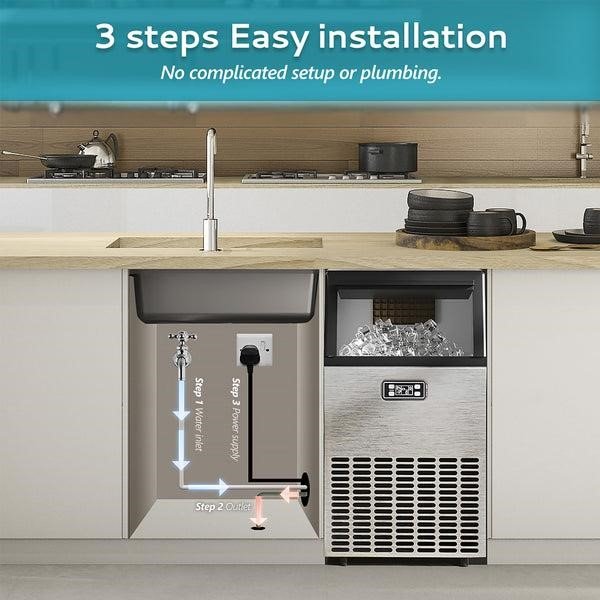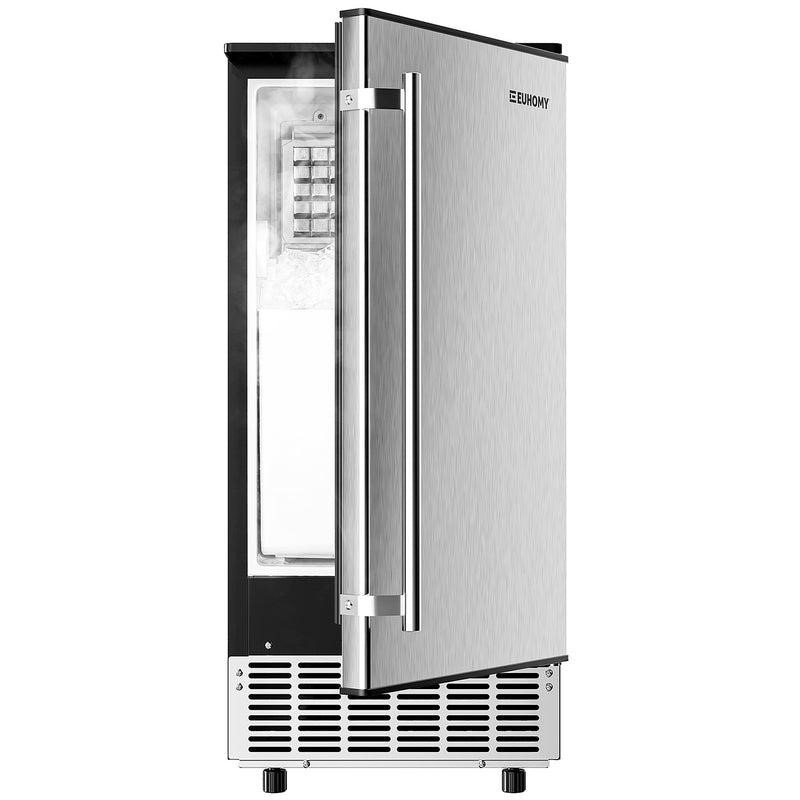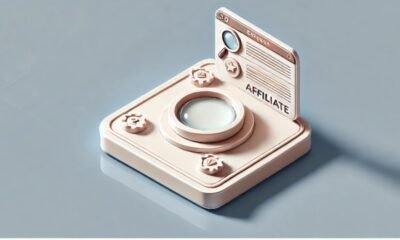Business
The Ultimate Guide to Commercial Ice Makers

In the fast-paced world of hospitality, a reliable supply of ice is not just a convenience—it’s a necessity. Commercial ice makers serve as the backbone of restaurants, bars, hotels, and cafes, ensuring that every beverage is served at the perfect temperature and every guest experience meets expectations. Without a dependable ice production system, businesses risk disappointing customers, slowing service, and ultimately losing revenue during peak hours.
The right commercial ice maker does more than simply freeze water. It becomes a strategic asset that supports operational efficiency, maintains food safety standards, and enhances customer satisfaction. Whether you’re running a bustling cocktail bar that goes through hundreds of pounds of ice nightly or managing a hotel breakfast service, understanding how to select and maintain the ideal ice-making equipment can significantly impact your bottom line. This comprehensive guide will walk you through everything you need to know about commercial ice makers, from understanding different types and features to making informed purchasing decisions that align with your specific business requirements.
Understanding Commercial Ice Makers
Commercial ice makers are specialized refrigeration units designed to produce large quantities of ice continuously throughout the day. Unlike residential ice makers that might produce a few pounds daily, commercial units can generate anywhere from 50 to over 1,000 pounds of ice per day, depending on the model and configuration. These machines work by circulating water over refrigerated metal plates or molds, where it freezes into specific ice shapes before being released into storage bins.
The market offers several distinct categories of commercial ice makers, each engineered for different operational demands. Modular units sit atop separate storage bins and provide the highest production capacity, making them ideal for large-scale operations. Undercounter models combine ice production and storage in a compact footprint, perfect for bars and smaller establishments with limited space. Countertop dispensers offer convenient access for self-service environments, while combination units integrate ice making with water or beverage dispensing capabilities. The type of ice produced also varies significantly—from classic cubes and half-cubes to nugget ice, flake ice, and gourmet ice shapes. Each ice type serves specific purposes, with cubes being versatile for most beverages, nugget ice popular in healthcare and soft drinks, and flake ice essential for food displays and blended drinks. Understanding these fundamental distinctions helps businesses identify which system architecture and ice type best matches their service style and customer preferences.
Key Features to Consider
When evaluating commercial ice makers, production capacity stands as the most critical specification to assess. This measurement, typically expressed in pounds per 24-hour period, must align with your peak demand rather than average usage. Calculate your busiest service periods and add a buffer of at least 20% to account for unexpected rushes or equipment inefficiencies during warmer months. A restaurant serving 200 customers daily might need 300-400 pounds of ice, while a busy nightclub could require upwards of 800 pounds during weekend operations.
Energy efficiency directly impacts long-term operating costs and environmental footprint. Look for ENERGY STAR certified models that use advanced insulation, efficient compressors, and optimized water circulation systems. These units may cost more initially but typically recover the investment within two to three years through reduced utility bills. Water consumption also deserves attention, as some models recirculate water more effectively than others, reducing waste and lowering water bills in areas with expensive municipal rates.
Durability and construction quality determine how well your ice maker withstands the demanding commercial environment. Stainless steel exteriors resist corrosion and simplify cleaning, while robust internal components handle continuous operation without frequent breakdowns. Consider the ambient temperature rating as well—kitchens often exceed 80 degrees Fahrenheit, and not all ice makers maintain optimal performance in high-heat environments. Finally, evaluate storage bin capacity separately from production rate, ensuring you have adequate reserves during peak service times without the machine running constantly to keep up with demand.
Types of Commercial Ice Makers
Commercial ice makers fall into several distinct categories based on their production methodology and installation configuration. Modular ice machines represent the workhorse of high-volume operations, consisting of separate ice-making heads mounted atop dedicated storage bins. These systems offer the greatest flexibility, allowing businesses to match production capacity with storage needs independently. A large hotel might pair a 1,000-pound production head with a 600-pound bin, ensuring continuous availability during conference events without overflow waste.

Undercounter ice makers integrate production and storage within a single compact unit that fits beneath standard countertops, typically producing 50 to 350 pounds daily. These space-efficient machines excel in bars, coffee shops, and small restaurants where floor space commands premium value. Countertop ice dispensers combine ice making with convenient self-service access, ideal for healthcare facilities, cafeterias, and quick-service restaurants where customers fill their own cups. These units often include built-in water dispensing and portion control features that reduce waste.
Beyond configuration, ice makers also differ in their freezing technology. Air-cooled models use ambient air to dissipate heat from the refrigeration system, making them the most common and economical choice for well-ventilated spaces. Water-cooled units circulate water through cooling coils, operating more quietly and efficiently in hot kitchens but consuming significantly more water. Remote-cooled systems place the noisy, heat-generating condenser outside the building, maintaining comfortable kitchen temperatures while reducing ambient noise—a premium solution for upscale dining establishments where kitchen aesthetics and acoustics matter.
Choosing the Right Ice Maker
Selecting the appropriate commercial ice maker begins with a thorough assessment of your actual ice consumption patterns. Track your usage over several weeks, paying special attention to peak periods like weekend nights, special events, or seasonal rushes. Multiply your highest single-day consumption by 1.2 to establish a safe production target that accounts for equipment downtime and unexpected demand spikes. A bar that uses 250 pounds on its busiest Saturday should consider a machine rated for at least 300 pounds daily production.
Physical space constraints and utility infrastructure significantly influence your options. Measure the installation area carefully, accounting for required clearances around the unit for ventilation and service access—most manufacturers specify at least six inches on ventilated sides. Verify that your electrical service can handle the machine’s amperage requirements, as larger units may need dedicated circuits or even three-phase power. Check water line pressure and drainage capacity, since inadequate water pressure below 20 PSI or poor drainage can severely impact performance and void warranties.
Budget considerations extend beyond the initial purchase price to encompass total cost of ownership. While a water-cooled unit might cost less upfront, calculate the ongoing water and sewer charges that could add hundreds of dollars monthly compared to an air-cooled equivalent. Factor in anticipated maintenance costs, warranty coverage, and the availability of local service technicians familiar with your chosen brand. Sometimes paying more for a well-supported model from a manufacturer with strong regional presence proves more economical than saving money on a unit that requires expensive service calls or long parts delays when problems arise.
Installation and Maintenance Tips
Proper installation begins with preparing the location according to manufacturer specifications. Ensure the floor is level and capable of supporting the combined weight of the machine, ice, and storage bin—a fully loaded 500-pound capacity unit can exceed 800 pounds total. Position the ice maker away from heat sources like ovens, dishwashers, and direct sunlight, as ambient temperatures above 90 degrees can reduce production by up to 20%. Install a dedicated water line with a shutoff valve and sediment filter to protect internal components from mineral buildup and debris. Connect to a floor drain with proper air gap to prevent backflow contamination, and verify electrical connections match voltage requirements exactly before powering on the unit.
Daily maintenance starts with simple visual inspections of ice quality and production rates. Cloudy or malformed ice indicates water quality issues or failing components requiring immediate attention. Weekly tasks include wiping down exterior surfaces with mild detergent, checking water filters for clogs, and inspecting door seals for wear that allows warm air infiltration. Monthly deep cleaning involves removing ice from the bin, sanitizing all food-contact surfaces with approved cleaners, and clearing the condenser coils of dust accumulation using a soft brush or vacuum attachment—dirty coils force the compressor to work harder, increasing energy costs and shortening equipment life.
Professional maintenance should occur every six months, with technicians performing comprehensive system checks including refrigerant levels, electrical connections, water inlet valve operation, and evaporator plate condition. Descaling the water system removes mineral deposits that impede ice formation and harbor bacteria. Replace water filters according to manufacturer schedules rather than waiting for visible problems, as degraded filters allow contaminants that damage pumps and valves. Keep detailed maintenance logs documenting all service activities, as this documentation proves invaluable for warranty claims and helps identify recurring issues before they cause complete breakdowns during your busiest service periods.
Energy Efficiency and Cost Savings
Energy-efficient commercial ice makers deliver substantial financial benefits that extend far beyond monthly utility bills. Modern ENERGY STAR certified units consume 10-20% less electricity and up to 30% less water compared to standard models, translating to savings of $200 to $500 annually depending on production capacity and local utility rates. Over a typical ten-year lifespan, these savings can exceed $4,000 while simultaneously reducing your business’s environmental impact. The efficiency gains come from advanced technologies including improved insulation that maintains cabinet temperatures with less compressor cycling, variable-speed fans that adjust cooling based on ambient conditions, and intelligent harvest cycles that minimize energy waste during ice release.
Water efficiency proves equally important in reducing operational costs, particularly in regions with high water and sewer rates. Traditional ice makers waste significant water through continuous condenser cooling and inefficient purge cycles that flush minerals from the system. Newer models incorporate water-saving features like recirculation systems that reuse water multiple times before disposal and optimized purge sequences that remove only necessary mineral buildup. Some advanced units include built-in water filtration that extends time between descaling, further reducing water waste. Calculating your potential savings requires examining both water consumption specifications and your local combined water-sewer rates—in cities where these costs exceed $15 per thousand gallons, water-efficient models can save an additional $150 to $300 annually, making the premium investment in efficient equipment financially prudent within just a few years of operation.
Commercial Ice Maker Models to Consider
The commercial ice maker market features several standout models that consistently earn praise from hospitality professionals for their reliability and performance. Modular ice machines from established manufacturers dominate high-volume applications, with units producing 800 to 1,200 pounds daily becoming the standard for full-service restaurants and hotels. These workhorses typically feature stainless steel construction, intuitive diagnostic systems that simplify troubleshooting, and modular component designs that allow technicians to replace parts quickly without removing the entire unit from service. Their separate bin configuration provides flexibility to expand storage capacity as business grows without replacing the production head.
Undercounter models have evolved significantly in recent years, with compact units now delivering 300 pounds daily while fitting standard 24-inch cabinet openings. These space-efficient machines incorporate front-breathing designs that eliminate side clearance requirements, making them ideal for tight bar installations. Many include built-in antimicrobial protection on ice contact surfaces and automatic cleaning cycles that reduce manual maintenance demands. For smaller operations or those just entering the market, brands like Euhomy offer accessible undercounter options that provide reliable performance for cafes and small restaurants looking to balance budget constraints with quality ice production.
Nugget ice makers have gained substantial market share, particularly in healthcare facilities, convenience stores, and casual dining establishments where customers prefer chewable ice. These specialized units produce soft, porous ice nuggets that absorb beverage flavors and cool drinks rapidly. Recent innovations include hybrid models that allow operators to switch between nugget and cube production based on seasonal demand or menu changes. Countertop dispensers with integrated filtration systems appeal to operations prioritizing water quality and taste, with touchless dispensing options gaining traction in health-conscious environments. When evaluating specific models, prioritize those with comprehensive warranties covering both parts and labor for at least three years, and verify that authorized service providers operate within reasonable distance of your location to minimize downtime during repairs.
Case Studies: Successful Implementations
A boutique hotel in Charleston, South Carolina transformed its guest experience by replacing an aging 400-pound modular unit with a modern 600-pound ENERGY STAR certified system. The property manager reported that the upgrade eliminated the chronic ice shortages that previously plagued their breakfast service and poolside bar during summer months. Within the first year, the hotel documented a 23% reduction in energy costs related to ice production and received noticeably fewer guest complaints about beverage service. The new machine’s antimicrobial components and automated cleaning cycles also helped the property maintain superior health inspection scores, while the quieter operation reduced noise complaints from rooms adjacent to the ice machine area.
A high-volume sports bar in Denver faced constant equipment failures with their original water-cooled system, which struggled to keep pace with demand during game nights when patronage tripled. After consulting with a refrigeration specialist, ownership invested in a remote-cooled modular system producing 1,000 pounds daily paired with an 800-pound storage bin. The remote condenser installation moved heat generation outside the building, reducing kitchen air conditioning loads by an estimated 15% while creating a more comfortable environment for staff. The bar owner calculated that despite the higher initial investment of approximately $8,000, the combination of eliminated service calls, reduced cooling costs, and increased customer satisfaction during peak periods generated positive return on investment within eighteen months.
A fast-casual restaurant chain specializing in blended beverages implemented standardized nugget ice makers across their fifteen locations after extensive testing revealed that customers strongly preferred the chewable ice texture. The corporate facilities team selected undercounter units producing 250 pounds daily, which perfectly matched average store demand while fitting existing counter configurations without costly renovations. Centralized purchasing negotiations secured volume discounts and established a preventive maintenance contract covering all locations. After two years of operation, the chain reported 97% uptime across all units, with the consistent ice quality becoming a differentiating factor that customers frequently mentioned in positive reviews and social media posts, demonstrating how the right equipment choice can enhance brand identity beyond mere operational efficiency.
Common Challenges and Solutions
Commercial ice makers frequently encounter water quality issues that manifest as cloudy ice, slow production, or premature equipment failure. Hard water containing excessive calcium and magnesium creates scale buildup on evaporator plates and water lines, reducing efficiency and ice quality. The solution involves installing a comprehensive water treatment system that includes both sediment filtration and scale inhibition. Replace filters every three to six months depending on water hardness, and schedule professional descaling treatments quarterly in areas with particularly mineral-rich water supplies.
Inadequate ice production during peak periods often stems from insufficient ventilation rather than equipment malfunction. When ice makers operate in enclosed spaces or near heat-generating equipment, ambient temperatures rise beyond optimal operating ranges, forcing compressors to work harder while producing less ice. Address this by ensuring minimum clearances around all ventilated surfaces, installing supplemental exhaust fans to remove heat buildup, or relocating the unit to a cooler area with better air circulation. Some operators successfully resolve chronic underproduction by upgrading to remote-cooled systems that eliminate heat concerns entirely.
Bacterial contamination and unpleasant ice odors typically result from inadequate cleaning protocols or compromised storage bin hygiene. Establish strict sanitation schedules that include weekly bin cleaning with food-safe sanitizers and monthly deep cleaning of all internal components. Train staff to handle ice only with dedicated scoops stored outside the bin, never allowing hands or glass containers to contact ice directly. Installing antimicrobial bin liners and UV sanitization systems provides additional protection against microbial growth in high-humidity environments where contamination risks run highest.
Making the Right Investment in Ice Production
Selecting and maintaining the right commercial ice maker represents a critical investment in your hospitality operation’s success. By understanding the different types of ice makers available, carefully evaluating your specific production needs, and prioritizing energy efficiency and build quality, you can ensure consistent ice availability that supports exceptional customer service. Regular maintenance and proper installation extend equipment lifespan while preventing costly downtime during peak business hours. Whether you’re outfitting a new establishment or upgrading existing equipment, the comprehensive considerations outlined in this guide will help you make informed decisions that balance immediate budget constraints with long-term operational efficiency. A reliable ice maker cube isn’t just equipment—it’s a foundational element of hospitality excellence that keeps beverages cold, customers satisfied, and your business running smoothly year-round.
-

 Tech1 year ago
Tech1 year agoHow to Use a Temporary Number for WhatsApp
-

 Business2 years ago
Business2 years agoSepatuindonesia.com | Best Online Store in Indonesia
-

 Social Media1 year ago
Social Media1 year agoThe Best Methods to Download TikTok Videos Using SnapTik
-

 Technology1 year ago
Technology1 year agoTop High Paying Affiliate Programs
-

 Tech9 months ago
Tech9 months agoUnderstanding thejavasea.me Leaks Aio-TLP: A Comprehensive Guide
-

 FOOD11 months ago
FOOD11 months agoHow to Identify Pure Desi Ghee? Ultimate Guidelines for Purchasing Authentic Ghee Online
-

 Instagram3 years ago
Instagram3 years agoFree Instagram Auto Follower Without Login
-

 Instagram3 years ago
Instagram3 years agoFree Instagram Follower Without Login





















